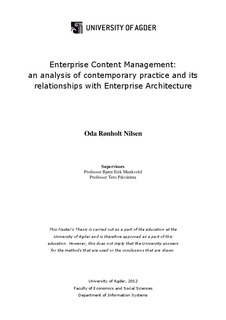| dc.description.abstract | Enterprise Content Management (ECM) consists of a wide set of interrelated issues, and previous research on ECM points out that there is a lack of a common understand of the concept itself. Further, there is a lack of a holistic approach to ECM and initiatives are often individual initiatives covering sub-parts of ECM. Organizations seem to have a more functional approach to ECM. Enterprise architecture (EA) is a concept which promises to provide a holistic and long-term view of a company’s processes, systems, and technologies so that individual projects can build capabilities – not just fulfill immediate needs. EA also promises to help organizations in complying with external regulations, tackling the increasing complexity of organization, capturing knowledge and guide solution architects. Within both the field of ECM and EA, there is a lack of empirical evidence. Some of the promises of EA seem to address some of the ECM issues that organizations are facing. Research on this relationship between ECM and EA is scarce.
My research question is: What are key issues in contemporary Enterprise Content Management practice, and how can these be related to the concept of Enterprise Architecture?
In order to answer the research question, I have reviewed previous literature on ECM and EA. A multiple case study was conducted to investigate current ECM issues in practice, involving interviews with ten people from the following five different: Devoteam, Vest-Agder county municipality, DNV Maritime Partner AS, Aker Solutions and Telenor. The results of the multiple case have been systemized using the major ECM issues framework (Päivärinta & Munkvold, 2005) and a functional ECM framework developed by Grahlmann et al. (2011) has been used to describe the identified ECM functionalities.
The study showed that there is still a lack of a common understanding about the concept of ECM. Organizations seem to lack a holistic approach to their ECM initiatives and are taking a more functional approach to them. A number of ECM issues were identified and systemized according to the major ECM issues framework. Through this systemiziation of the results, previous statements about ECM being about a set of interrelated issues are confirmed. However, the organizations themselves seem only partly aware of this fact. The cases in the study had varying enterprise models. Furthermore, the objectives and impacts sought with the ECM initiatives vary in the cases I studied, but mostly overlap with previously identified objectives and impacts. However, new challenges related to previously identified objectives such as the increasing number of information channel and ECM initiatives involving principles of social media were identified. There still seems to be little focus on the content model although previous research indicates that understanding the role of the content itself is crucial in ECM initiatives. Attention given to the content life cycle was also scarce and focused on the creation and using of content phases which is, according to the cases, because it is in these phases that they generate money. The technological infrastructure did not always fully support the implementation of identified ECM objectives. Administrative issues received varying attention in the different cases and some of the cases had established service organizations to upkeep ECM and support the users. Change management issues were given the least attention of all the interrelated issues. The EA view is not very present in practice according to my findings, and I found no explicit indication that ECM and EA are being related to each other in current practice. However, when relating current ECM issues to previous research on EA, there appears to be some relationships between the two concepts. | no_NO |
